University Report: Silver Resistance to Antibiotics Research
VerifiedAdded on 2022/11/25
|7
|1522
|327
Report
AI Summary
This report investigates the growing concern of silver resistance to antibiotics, a critical issue in global health. The research focuses on the mechanisms of bacterial resistance, particularly the role of the SilE protein and the implications of silver's increasing use in medical and non-medical applications. The report explores the genetic mutations, efflux pumps, and protein binding involved in resistance, drawing on previous studies and current research to understand how bacteria develop tolerance to silver. It highlights the potential for therapeutic failures and the need for advanced research to combat cross-resistance and develop new strategies to overcome bacterial defenses. The report also discusses the importance of understanding the molecular mechanisms of silver resistance to improve antibiotic efficacy and address the threat of multidrug resistance. The document, contributed by a student and available on Desklib, provides valuable insights into this complex and evolving field, emphasizing the need for global solutions and further scientific exploration to protect human health.
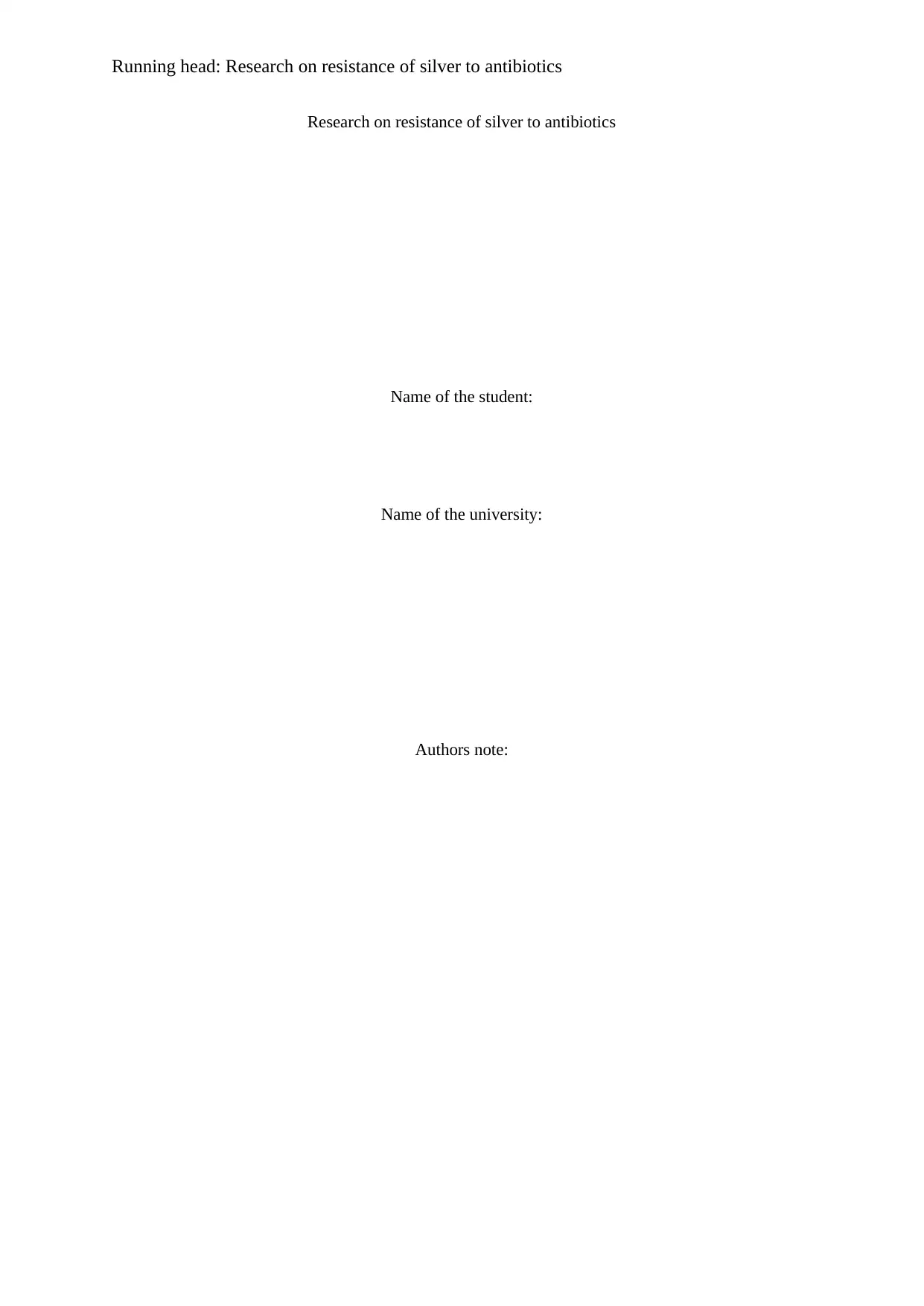
Running head: Research on resistance of silver to antibiotics
Research on resistance of silver to antibiotics
Name of the student:
Name of the university:
Authors note:
Research on resistance of silver to antibiotics
Name of the student:
Name of the university:
Authors note:
Paraphrase This Document
Need a fresh take? Get an instant paraphrase of this document with our AI Paraphraser

1RESEARCH ON RESISTANCE OF SILVER TO ANTIBIOTICS
Table of Contents
Abstract......................................................................................................................................2
Importance of the research:........................................................................................................2
Background................................................................................................................................4
Previous studies..........................................................................................................................6
References..................................................................................................................................8
Table of Contents
Abstract......................................................................................................................................2
Importance of the research:........................................................................................................2
Background................................................................................................................................4
Previous studies..........................................................................................................................6
References..................................................................................................................................8
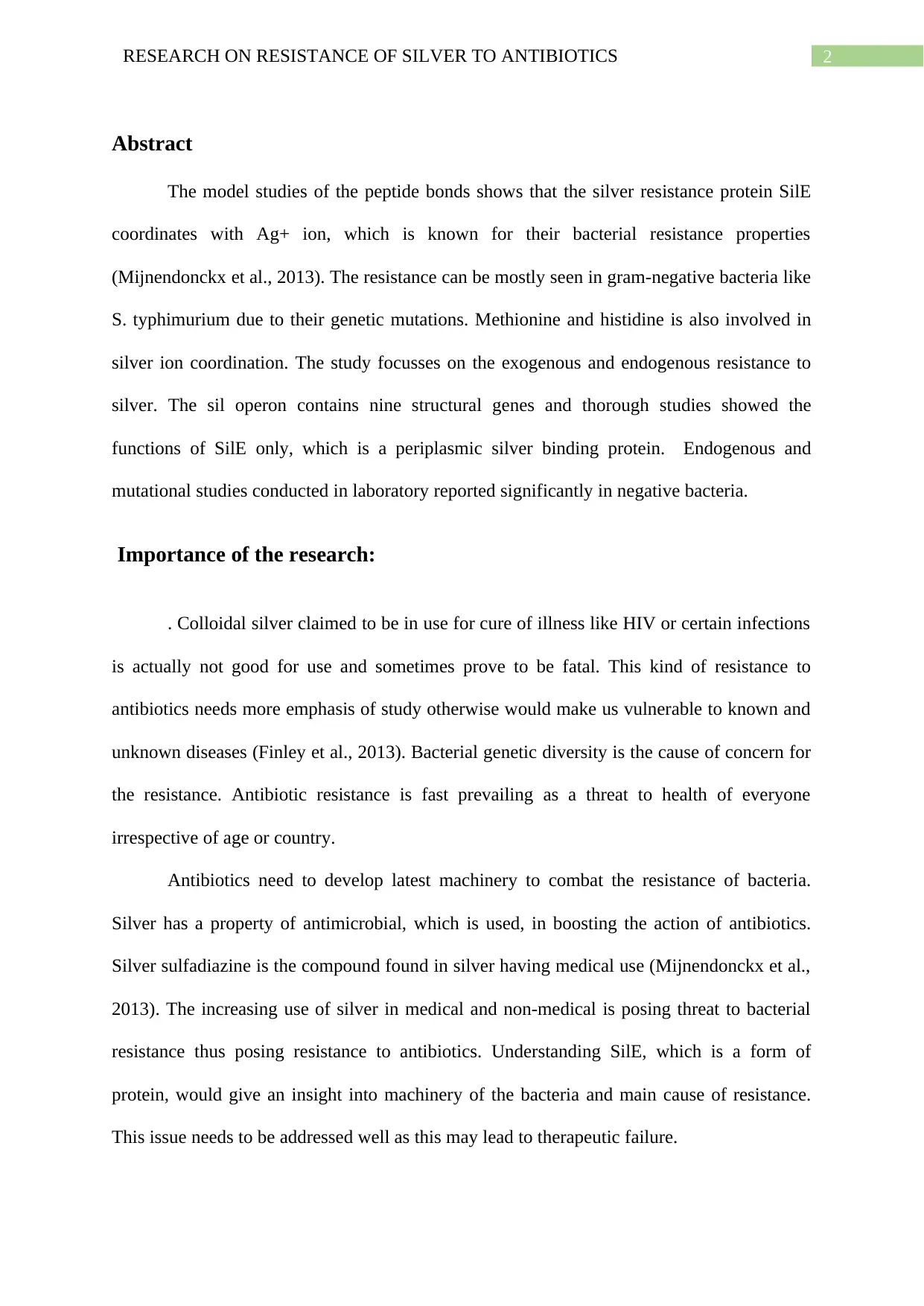
2RESEARCH ON RESISTANCE OF SILVER TO ANTIBIOTICS
Abstract
The model studies of the peptide bonds shows that the silver resistance protein SilE
coordinates with Ag+ ion, which is known for their bacterial resistance properties
(Mijnendonckx et al., 2013). The resistance can be mostly seen in gram-negative bacteria like
S. typhimurium due to their genetic mutations. Methionine and histidine is also involved in
silver ion coordination. The study focusses on the exogenous and endogenous resistance to
silver. The sil operon contains nine structural genes and thorough studies showed the
functions of SilE only, which is a periplasmic silver binding protein. Endogenous and
mutational studies conducted in laboratory reported significantly in negative bacteria.
Importance of the research:
. Colloidal silver claimed to be in use for cure of illness like HIV or certain infections
is actually not good for use and sometimes prove to be fatal. This kind of resistance to
antibiotics needs more emphasis of study otherwise would make us vulnerable to known and
unknown diseases (Finley et al., 2013). Bacterial genetic diversity is the cause of concern for
the resistance. Antibiotic resistance is fast prevailing as a threat to health of everyone
irrespective of age or country.
Antibiotics need to develop latest machinery to combat the resistance of bacteria.
Silver has a property of antimicrobial, which is used, in boosting the action of antibiotics.
Silver sulfadiazine is the compound found in silver having medical use (Mijnendonckx et al.,
2013). The increasing use of silver in medical and non-medical is posing threat to bacterial
resistance thus posing resistance to antibiotics. Understanding SilE, which is a form of
protein, would give an insight into machinery of the bacteria and main cause of resistance.
This issue needs to be addressed well as this may lead to therapeutic failure.
Abstract
The model studies of the peptide bonds shows that the silver resistance protein SilE
coordinates with Ag+ ion, which is known for their bacterial resistance properties
(Mijnendonckx et al., 2013). The resistance can be mostly seen in gram-negative bacteria like
S. typhimurium due to their genetic mutations. Methionine and histidine is also involved in
silver ion coordination. The study focusses on the exogenous and endogenous resistance to
silver. The sil operon contains nine structural genes and thorough studies showed the
functions of SilE only, which is a periplasmic silver binding protein. Endogenous and
mutational studies conducted in laboratory reported significantly in negative bacteria.
Importance of the research:
. Colloidal silver claimed to be in use for cure of illness like HIV or certain infections
is actually not good for use and sometimes prove to be fatal. This kind of resistance to
antibiotics needs more emphasis of study otherwise would make us vulnerable to known and
unknown diseases (Finley et al., 2013). Bacterial genetic diversity is the cause of concern for
the resistance. Antibiotic resistance is fast prevailing as a threat to health of everyone
irrespective of age or country.
Antibiotics need to develop latest machinery to combat the resistance of bacteria.
Silver has a property of antimicrobial, which is used, in boosting the action of antibiotics.
Silver sulfadiazine is the compound found in silver having medical use (Mijnendonckx et al.,
2013). The increasing use of silver in medical and non-medical is posing threat to bacterial
resistance thus posing resistance to antibiotics. Understanding SilE, which is a form of
protein, would give an insight into machinery of the bacteria and main cause of resistance.
This issue needs to be addressed well as this may lead to therapeutic failure.
⊘ This is a preview!⊘
Do you want full access?
Subscribe today to unlock all pages.

Trusted by 1+ million students worldwide
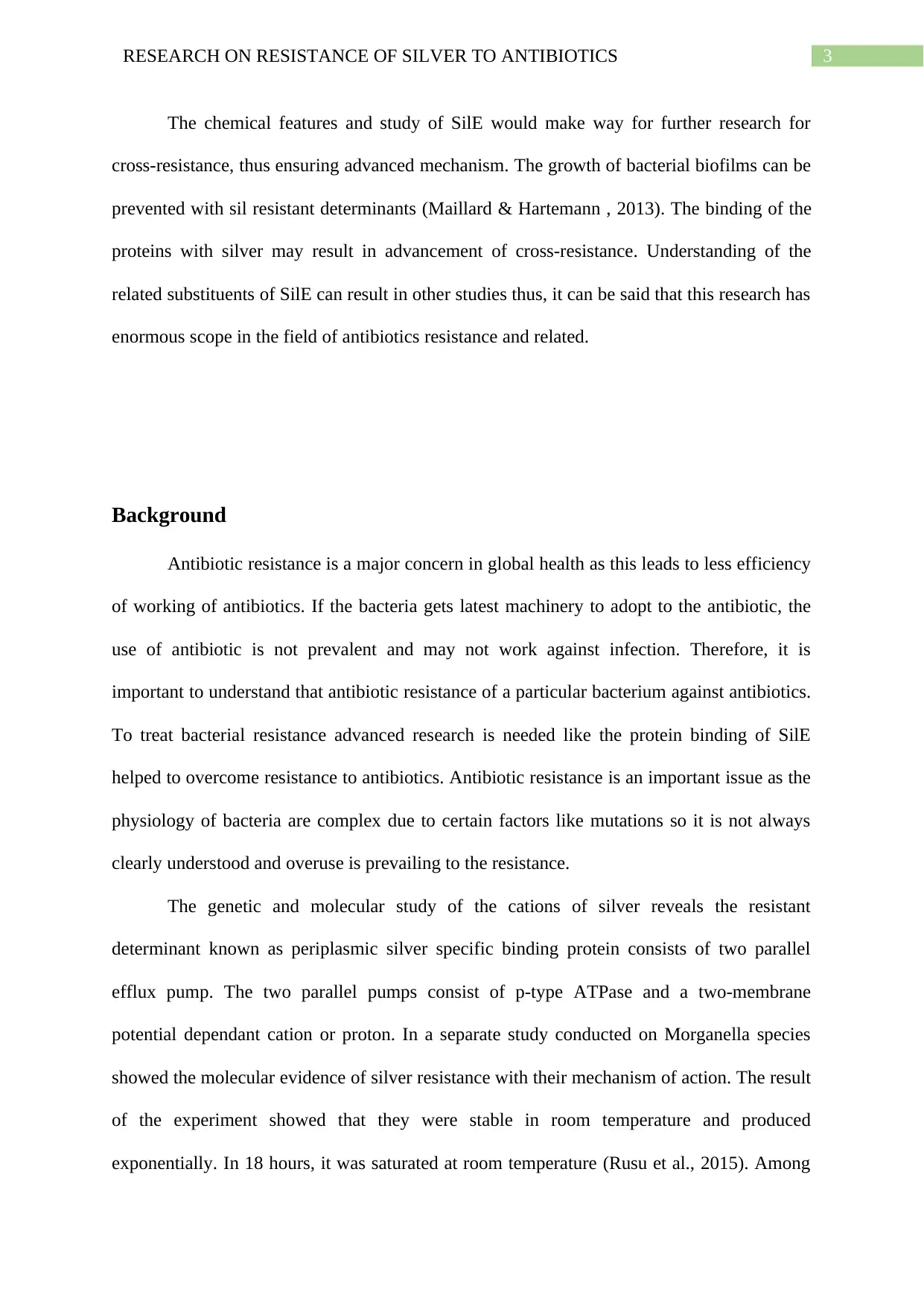
3RESEARCH ON RESISTANCE OF SILVER TO ANTIBIOTICS
The chemical features and study of SilE would make way for further research for
cross-resistance, thus ensuring advanced mechanism. The growth of bacterial biofilms can be
prevented with sil resistant determinants (Maillard & Hartemann , 2013). The binding of the
proteins with silver may result in advancement of cross-resistance. Understanding of the
related substituents of SilE can result in other studies thus, it can be said that this research has
enormous scope in the field of antibiotics resistance and related.
Background
Antibiotic resistance is a major concern in global health as this leads to less efficiency
of working of antibiotics. If the bacteria gets latest machinery to adopt to the antibiotic, the
use of antibiotic is not prevalent and may not work against infection. Therefore, it is
important to understand that antibiotic resistance of a particular bacterium against antibiotics.
To treat bacterial resistance advanced research is needed like the protein binding of SilE
helped to overcome resistance to antibiotics. Antibiotic resistance is an important issue as the
physiology of bacteria are complex due to certain factors like mutations so it is not always
clearly understood and overuse is prevailing to the resistance.
The genetic and molecular study of the cations of silver reveals the resistant
determinant known as periplasmic silver specific binding protein consists of two parallel
efflux pump. The two parallel pumps consist of p-type ATPase and a two-membrane
potential dependant cation or proton. In a separate study conducted on Morganella species
showed the molecular evidence of silver resistance with their mechanism of action. The result
of the experiment showed that they were stable in room temperature and produced
exponentially. In 18 hours, it was saturated at room temperature (Rusu et al., 2015). Among
The chemical features and study of SilE would make way for further research for
cross-resistance, thus ensuring advanced mechanism. The growth of bacterial biofilms can be
prevented with sil resistant determinants (Maillard & Hartemann , 2013). The binding of the
proteins with silver may result in advancement of cross-resistance. Understanding of the
related substituents of SilE can result in other studies thus, it can be said that this research has
enormous scope in the field of antibiotics resistance and related.
Background
Antibiotic resistance is a major concern in global health as this leads to less efficiency
of working of antibiotics. If the bacteria gets latest machinery to adopt to the antibiotic, the
use of antibiotic is not prevalent and may not work against infection. Therefore, it is
important to understand that antibiotic resistance of a particular bacterium against antibiotics.
To treat bacterial resistance advanced research is needed like the protein binding of SilE
helped to overcome resistance to antibiotics. Antibiotic resistance is an important issue as the
physiology of bacteria are complex due to certain factors like mutations so it is not always
clearly understood and overuse is prevailing to the resistance.
The genetic and molecular study of the cations of silver reveals the resistant
determinant known as periplasmic silver specific binding protein consists of two parallel
efflux pump. The two parallel pumps consist of p-type ATPase and a two-membrane
potential dependant cation or proton. In a separate study conducted on Morganella species
showed the molecular evidence of silver resistance with their mechanism of action. The result
of the experiment showed that they were stable in room temperature and produced
exponentially. In 18 hours, it was saturated at room temperature (Rusu et al., 2015). Among
Paraphrase This Document
Need a fresh take? Get an instant paraphrase of this document with our AI Paraphraser
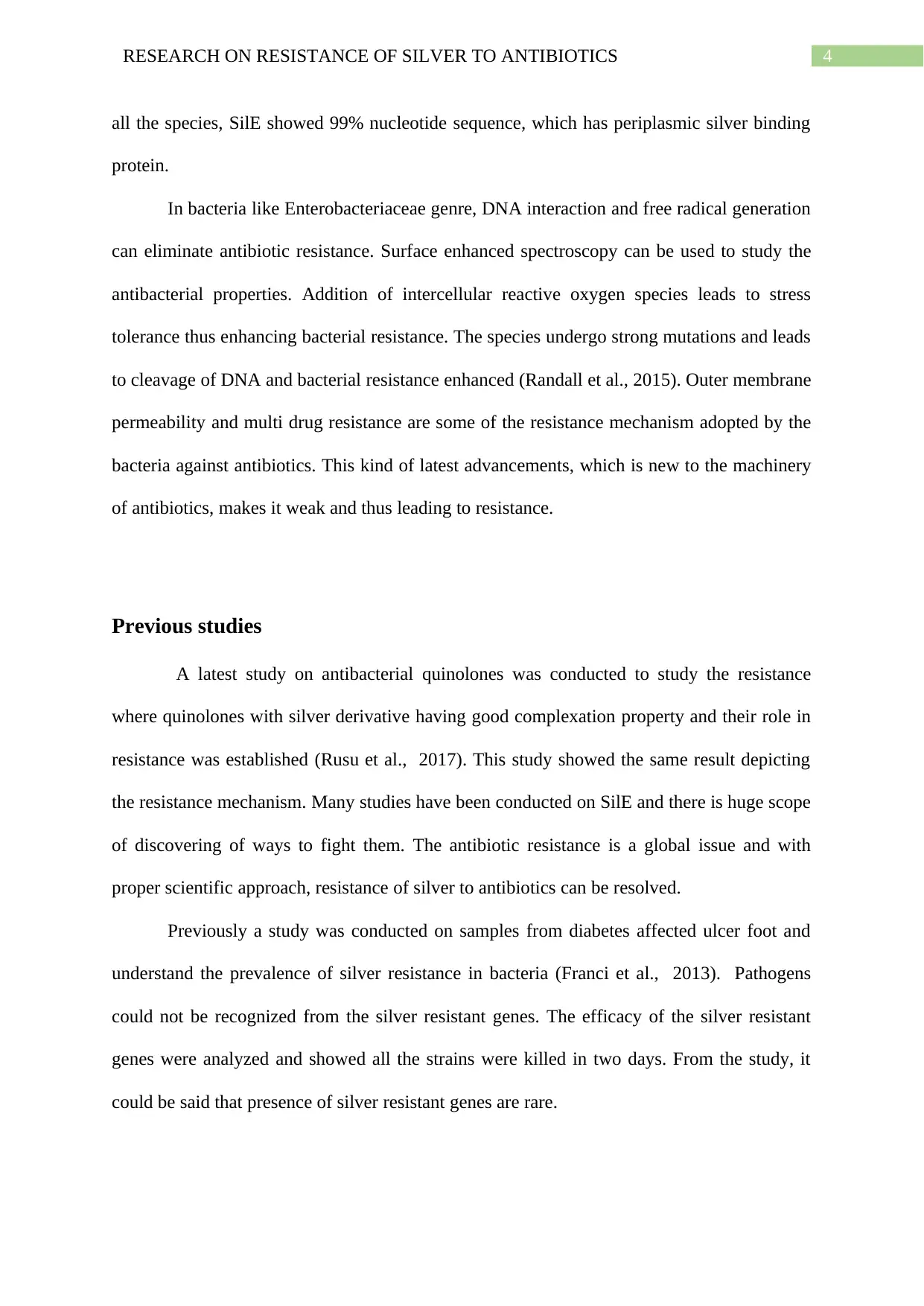
4RESEARCH ON RESISTANCE OF SILVER TO ANTIBIOTICS
all the species, SilE showed 99% nucleotide sequence, which has periplasmic silver binding
protein.
In bacteria like Enterobacteriaceae genre, DNA interaction and free radical generation
can eliminate antibiotic resistance. Surface enhanced spectroscopy can be used to study the
antibacterial properties. Addition of intercellular reactive oxygen species leads to stress
tolerance thus enhancing bacterial resistance. The species undergo strong mutations and leads
to cleavage of DNA and bacterial resistance enhanced (Randall et al., 2015). Outer membrane
permeability and multi drug resistance are some of the resistance mechanism adopted by the
bacteria against antibiotics. This kind of latest advancements, which is new to the machinery
of antibiotics, makes it weak and thus leading to resistance.
Previous studies
A latest study on antibacterial quinolones was conducted to study the resistance
where quinolones with silver derivative having good complexation property and their role in
resistance was established (Rusu et al., 2017). This study showed the same result depicting
the resistance mechanism. Many studies have been conducted on SilE and there is huge scope
of discovering of ways to fight them. The antibiotic resistance is a global issue and with
proper scientific approach, resistance of silver to antibiotics can be resolved.
Previously a study was conducted on samples from diabetes affected ulcer foot and
understand the prevalence of silver resistance in bacteria (Franci et al., 2013). Pathogens
could not be recognized from the silver resistant genes. The efficacy of the silver resistant
genes were analyzed and showed all the strains were killed in two days. From the study, it
could be said that presence of silver resistant genes are rare.
all the species, SilE showed 99% nucleotide sequence, which has periplasmic silver binding
protein.
In bacteria like Enterobacteriaceae genre, DNA interaction and free radical generation
can eliminate antibiotic resistance. Surface enhanced spectroscopy can be used to study the
antibacterial properties. Addition of intercellular reactive oxygen species leads to stress
tolerance thus enhancing bacterial resistance. The species undergo strong mutations and leads
to cleavage of DNA and bacterial resistance enhanced (Randall et al., 2015). Outer membrane
permeability and multi drug resistance are some of the resistance mechanism adopted by the
bacteria against antibiotics. This kind of latest advancements, which is new to the machinery
of antibiotics, makes it weak and thus leading to resistance.
Previous studies
A latest study on antibacterial quinolones was conducted to study the resistance
where quinolones with silver derivative having good complexation property and their role in
resistance was established (Rusu et al., 2017). This study showed the same result depicting
the resistance mechanism. Many studies have been conducted on SilE and there is huge scope
of discovering of ways to fight them. The antibiotic resistance is a global issue and with
proper scientific approach, resistance of silver to antibiotics can be resolved.
Previously a study was conducted on samples from diabetes affected ulcer foot and
understand the prevalence of silver resistance in bacteria (Franci et al., 2013). Pathogens
could not be recognized from the silver resistant genes. The efficacy of the silver resistant
genes were analyzed and showed all the strains were killed in two days. From the study, it
could be said that presence of silver resistant genes are rare.
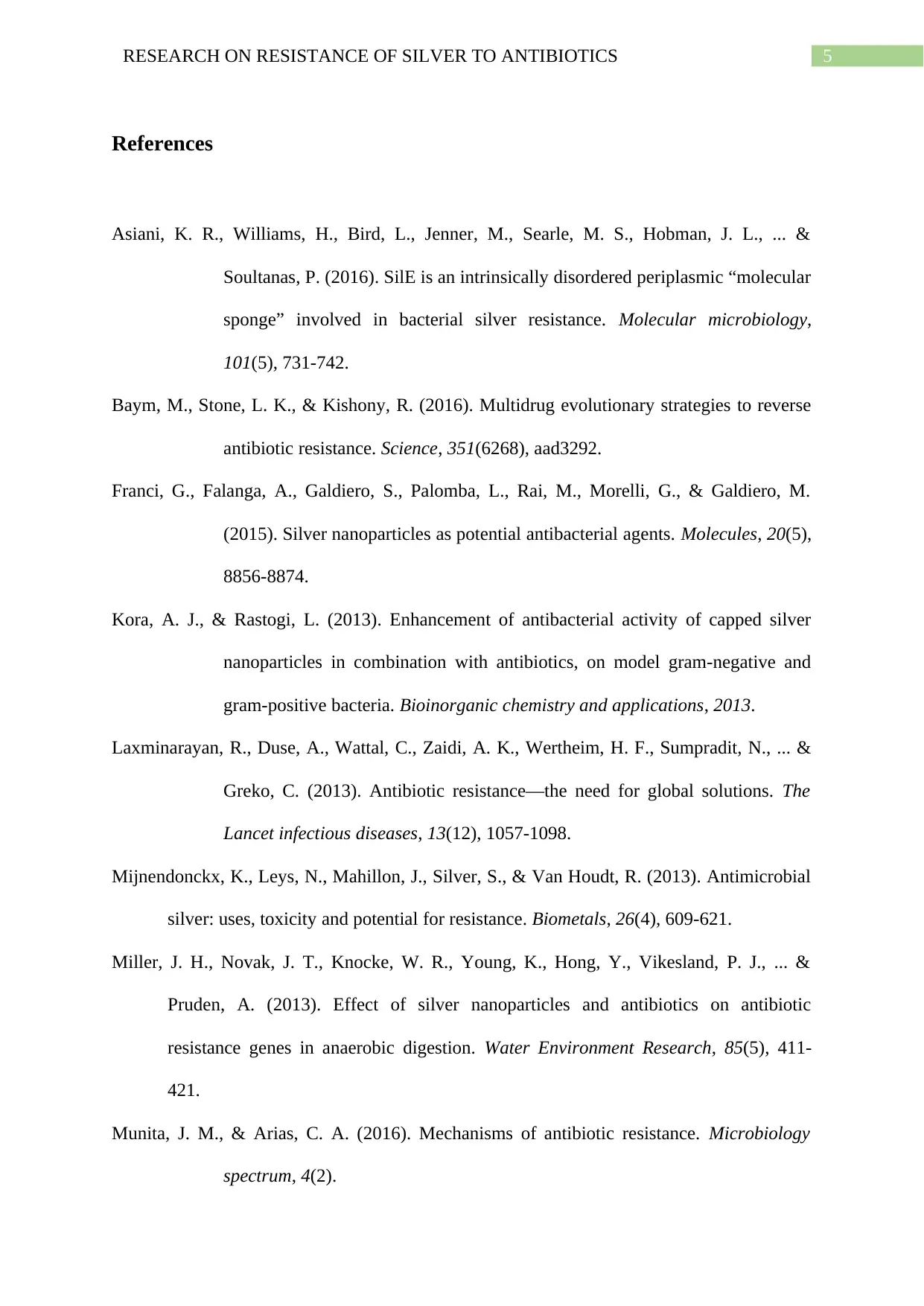
5RESEARCH ON RESISTANCE OF SILVER TO ANTIBIOTICS
References
Asiani, K. R., Williams, H., Bird, L., Jenner, M., Searle, M. S., Hobman, J. L., ... &
Soultanas, P. (2016). SilE is an intrinsically disordered periplasmic “molecular
sponge” involved in bacterial silver resistance. Molecular microbiology,
101(5), 731-742.
Baym, M., Stone, L. K., & Kishony, R. (2016). Multidrug evolutionary strategies to reverse
antibiotic resistance. Science, 351(6268), aad3292.
Franci, G., Falanga, A., Galdiero, S., Palomba, L., Rai, M., Morelli, G., & Galdiero, M.
(2015). Silver nanoparticles as potential antibacterial agents. Molecules, 20(5),
8856-8874.
Kora, A. J., & Rastogi, L. (2013). Enhancement of antibacterial activity of capped silver
nanoparticles in combination with antibiotics, on model gram-negative and
gram-positive bacteria. Bioinorganic chemistry and applications, 2013.
Laxminarayan, R., Duse, A., Wattal, C., Zaidi, A. K., Wertheim, H. F., Sumpradit, N., ... &
Greko, C. (2013). Antibiotic resistance—the need for global solutions. The
Lancet infectious diseases, 13(12), 1057-1098.
Mijnendonckx, K., Leys, N., Mahillon, J., Silver, S., & Van Houdt, R. (2013). Antimicrobial
silver: uses, toxicity and potential for resistance. Biometals, 26(4), 609-621.
Miller, J. H., Novak, J. T., Knocke, W. R., Young, K., Hong, Y., Vikesland, P. J., ... &
Pruden, A. (2013). Effect of silver nanoparticles and antibiotics on antibiotic
resistance genes in anaerobic digestion. Water Environment Research, 85(5), 411-
421.
Munita, J. M., & Arias, C. A. (2016). Mechanisms of antibiotic resistance. Microbiology
spectrum, 4(2).
References
Asiani, K. R., Williams, H., Bird, L., Jenner, M., Searle, M. S., Hobman, J. L., ... &
Soultanas, P. (2016). SilE is an intrinsically disordered periplasmic “molecular
sponge” involved in bacterial silver resistance. Molecular microbiology,
101(5), 731-742.
Baym, M., Stone, L. K., & Kishony, R. (2016). Multidrug evolutionary strategies to reverse
antibiotic resistance. Science, 351(6268), aad3292.
Franci, G., Falanga, A., Galdiero, S., Palomba, L., Rai, M., Morelli, G., & Galdiero, M.
(2015). Silver nanoparticles as potential antibacterial agents. Molecules, 20(5),
8856-8874.
Kora, A. J., & Rastogi, L. (2013). Enhancement of antibacterial activity of capped silver
nanoparticles in combination with antibiotics, on model gram-negative and
gram-positive bacteria. Bioinorganic chemistry and applications, 2013.
Laxminarayan, R., Duse, A., Wattal, C., Zaidi, A. K., Wertheim, H. F., Sumpradit, N., ... &
Greko, C. (2013). Antibiotic resistance—the need for global solutions. The
Lancet infectious diseases, 13(12), 1057-1098.
Mijnendonckx, K., Leys, N., Mahillon, J., Silver, S., & Van Houdt, R. (2013). Antimicrobial
silver: uses, toxicity and potential for resistance. Biometals, 26(4), 609-621.
Miller, J. H., Novak, J. T., Knocke, W. R., Young, K., Hong, Y., Vikesland, P. J., ... &
Pruden, A. (2013). Effect of silver nanoparticles and antibiotics on antibiotic
resistance genes in anaerobic digestion. Water Environment Research, 85(5), 411-
421.
Munita, J. M., & Arias, C. A. (2016). Mechanisms of antibiotic resistance. Microbiology
spectrum, 4(2).
⊘ This is a preview!⊘
Do you want full access?
Subscribe today to unlock all pages.

Trusted by 1+ million students worldwide
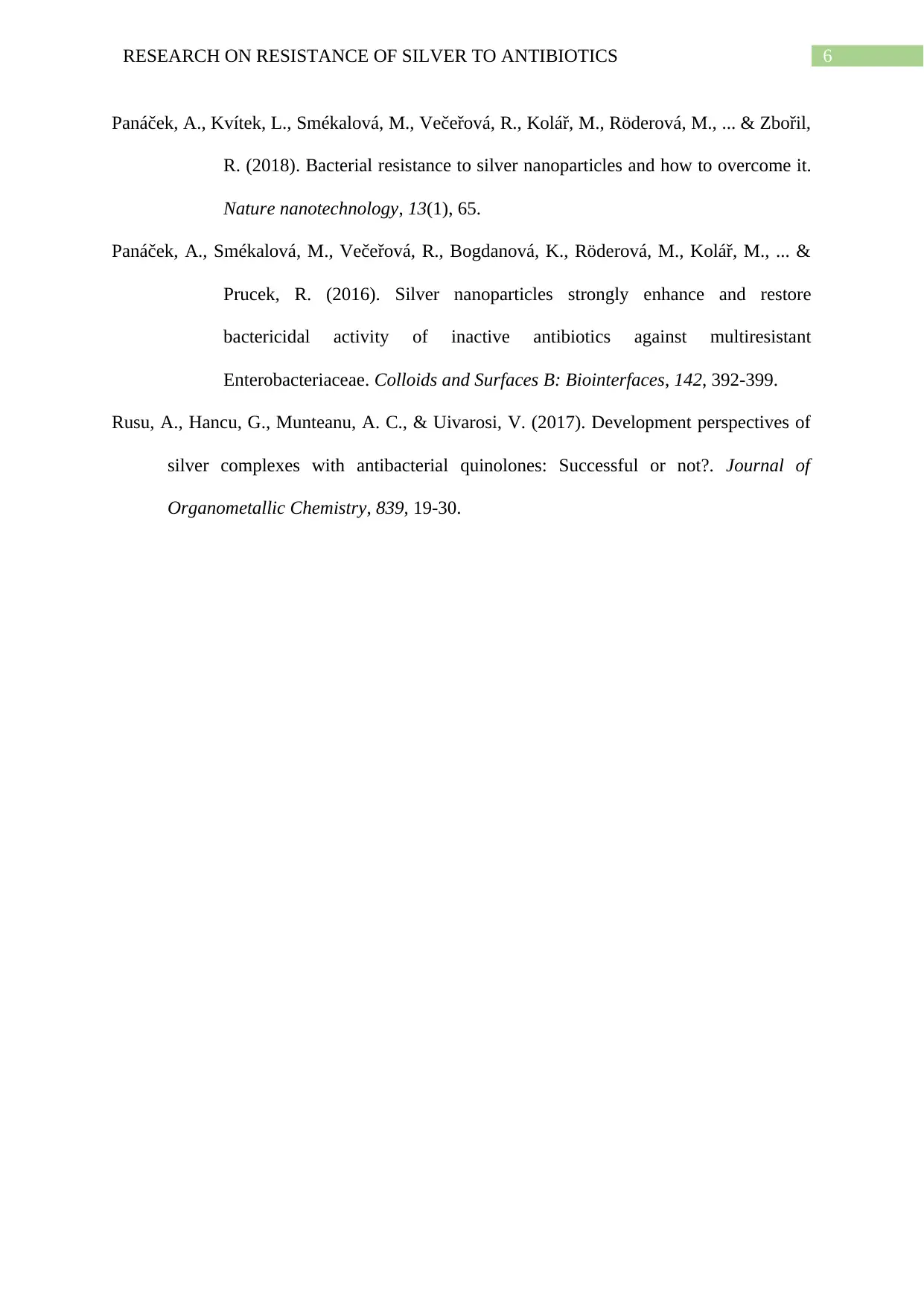
6RESEARCH ON RESISTANCE OF SILVER TO ANTIBIOTICS
Panáček, A., Kvítek, L., Smékalová, M., Večeřová, R., Kolář, M., Röderová, M., ... & Zbořil,
R. (2018). Bacterial resistance to silver nanoparticles and how to overcome it.
Nature nanotechnology, 13(1), 65.
Panáček, A., Smékalová, M., Večeřová, R., Bogdanová, K., Röderová, M., Kolář, M., ... &
Prucek, R. (2016). Silver nanoparticles strongly enhance and restore
bactericidal activity of inactive antibiotics against multiresistant
Enterobacteriaceae. Colloids and Surfaces B: Biointerfaces, 142, 392-399.
Rusu, A., Hancu, G., Munteanu, A. C., & Uivarosi, V. (2017). Development perspectives of
silver complexes with antibacterial quinolones: Successful or not?. Journal of
Organometallic Chemistry, 839, 19-30.
Panáček, A., Kvítek, L., Smékalová, M., Večeřová, R., Kolář, M., Röderová, M., ... & Zbořil,
R. (2018). Bacterial resistance to silver nanoparticles and how to overcome it.
Nature nanotechnology, 13(1), 65.
Panáček, A., Smékalová, M., Večeřová, R., Bogdanová, K., Röderová, M., Kolář, M., ... &
Prucek, R. (2016). Silver nanoparticles strongly enhance and restore
bactericidal activity of inactive antibiotics against multiresistant
Enterobacteriaceae. Colloids and Surfaces B: Biointerfaces, 142, 392-399.
Rusu, A., Hancu, G., Munteanu, A. C., & Uivarosi, V. (2017). Development perspectives of
silver complexes with antibacterial quinolones: Successful or not?. Journal of
Organometallic Chemistry, 839, 19-30.
1 out of 7
Related Documents
Your All-in-One AI-Powered Toolkit for Academic Success.
+13062052269
info@desklib.com
Available 24*7 on WhatsApp / Email
![[object Object]](/_next/static/media/star-bottom.7253800d.svg)
Unlock your academic potential
Copyright © 2020–2025 A2Z Services. All Rights Reserved. Developed and managed by ZUCOL.




